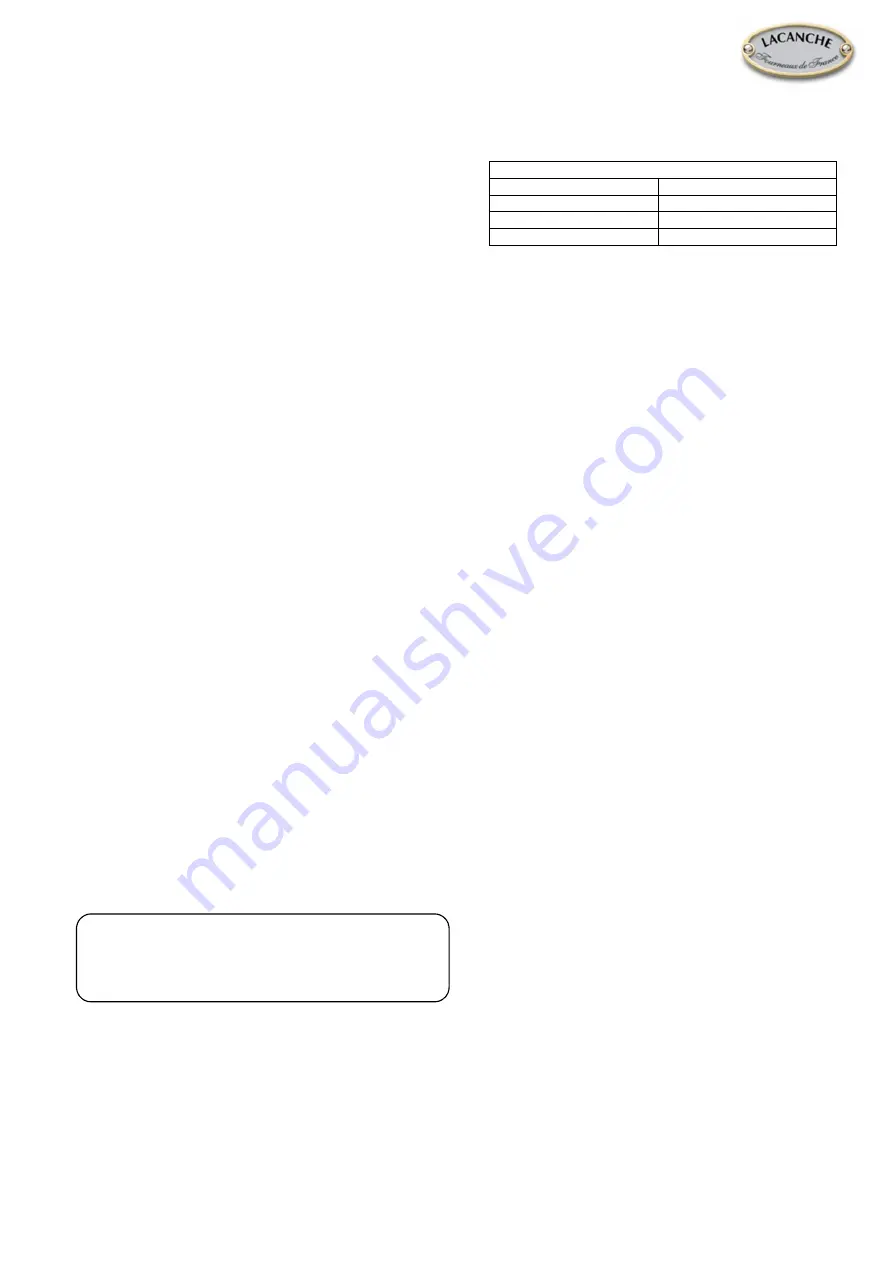
Café Moderne Range Hoods
Installation, Operating & Maintenance Instructions
W1512 FMOD Moderne Range Hood O&M Dec 16.docx
Page 3
Fornair
Method
Mark a horizontal line on the wall where the bottom edge of
the hood needs to be - if you have already fitted a splashback
then the top edge of this will serve.
Mark a vertical centre line, up to the desired chimney height,
to help you to accurately position the hood and chimney
bracket later.
Remove the grease filters to gain access the internal fixing
holes.
Mark the positions of the hood fixing hole centres and prepare
the wall to accept your chosen fixings, see Figure 2 “Layout of
Hood Rear”.
Tip.
The easiest way to mark fixing hole positions on the wall
is to offer up the hood in the desired position and then mark
the wall through the fixing holes in the hood rear (working
through the filter openings).
This is a 2-person job.
Mark and prepare hole(s) suitable to accommodate 150mm
diameter ducting. A 175mm diameter hole is recommended to
provide some alignment tolerance and allow clearance for any
clips used to secure the duct or cables passing through to
remote motors. If using the rear exhaust spigot position then
accuracy is critical, see Figure 2.
Secure the hood, using fixings suitable for the wall
construction, in the previously marked positions
Tip
. To use the rear exhaust spigot position you may have to
connect the ducting prior to fixing the hood to the wall - rigid
ducting is strongly recommended.
Unscrew the chimney bracket from the inner telescopic
chimney section and mark the positions of the chimney fixing
bracket holes on your wall.
Please note:
The bracket finishes flush with the finished top
of the chimney and the central hole can be used to view your
centre line.
Tip.
The easiest way to mark fixing hole positions on the wall
is to offer the bracket up into the desired position and then
mark the wall through the fixing holes in the bracket rear.
Secure the chimney bracket, using fixings suitable for the wall
construction, in the previously marked positions.
Connect the ducting and electrical supply cord as described in
section 4.6 and 4.7.
Slide the inner chimney up and over the bracket and secure it
in position using the screws previously removed.
4.6. Electrical Supply
The extractor is a stationary appliance designed to be
connected by fixed wiring to the electrical supply. A competent
Part P registered electrical technician must perform the
electrical installation.
The hood must be fed from a 230Vac single phase electrical
supply using a switched spur fitted with a 3A fuse. The spur
should be located adjacent to the hood/cooker so that the
supply can be disconnected from the hood using the switch.
The means of disconnection from the supply must have a
minimum contact separation of 3mm in all poles. Alternatively,
a means of disconnection in the fixed wiring according to the
relevant wiring rules must be fitted.
The appliance is supplied with an electrical supply flex for
connection to the electrical supply. The mains supply is
connected to the free end of this flex as follows:
INCOMING SUPPLY CORD CONNECTIONS
Core
Core Colour
Live
Brown
Neutral
Blue
Protective Earth
Green/Yellow
4.7. Connecting the Ducting
Whether you start running ducting at the hood end or at the
termination point (where it exits the building) will depend upon
your site conditions. There is no right or wrong order,
providing that ducting is installed so that it is as smooth as
possible and can be disconnected should the need arise for
maintenance.
Terminate the ducting where it exits the building. If using a
wall mounted weather louvre, secure the ducting to the louvre
spigot and attach the louvre to the wall. Ensure that the air fins
are directed downwards. If you are fitting an alternative
termination, ensure that the ducting is secure.
If using expanding foam, make sure that any flexible ducting is
supported internally to prevent it crushing where foamed.
Pull flexible ducting back along its route such that it is as
smooth as possible.
Connect ducting to extractor exhaust spigot using plastic tie
straps or a suitable alternative (e.g. jubilee clip) - do not use
duct tape as the sole means of connection. For rear exit
exhaust positions the duct should be attached prior to fixing
the extractor to the wall.
When the extractor is in position, check that the duct has not
been flattened or kinked along its route.
Note: Internal motor models have non-return flaps as part of
the spigot assembly to reduce air blowing back into the unit
from outside.
Take care not to obstruct the backdraught flaps when
connecting ducting, making sure that the ducting is not
preventing the flaps from opening properly. This is most
commonly a problem that can be encountered when flexible
ducting is used and we recommend semi-rigid ducting is used
instead. Overtightening of jubilee clips close to the base of the
spigot can also prevent the flaps from opening properly. If you
have installed non-return flaps elsewhere and draughts are
unlikely to cause a problem, then these flaps are easily
removed.
ELECTRICAL HAZARD
DISCONNECT ELECTRICAL SUPPLY
BEFORE PROCEEDING FURTHER


























